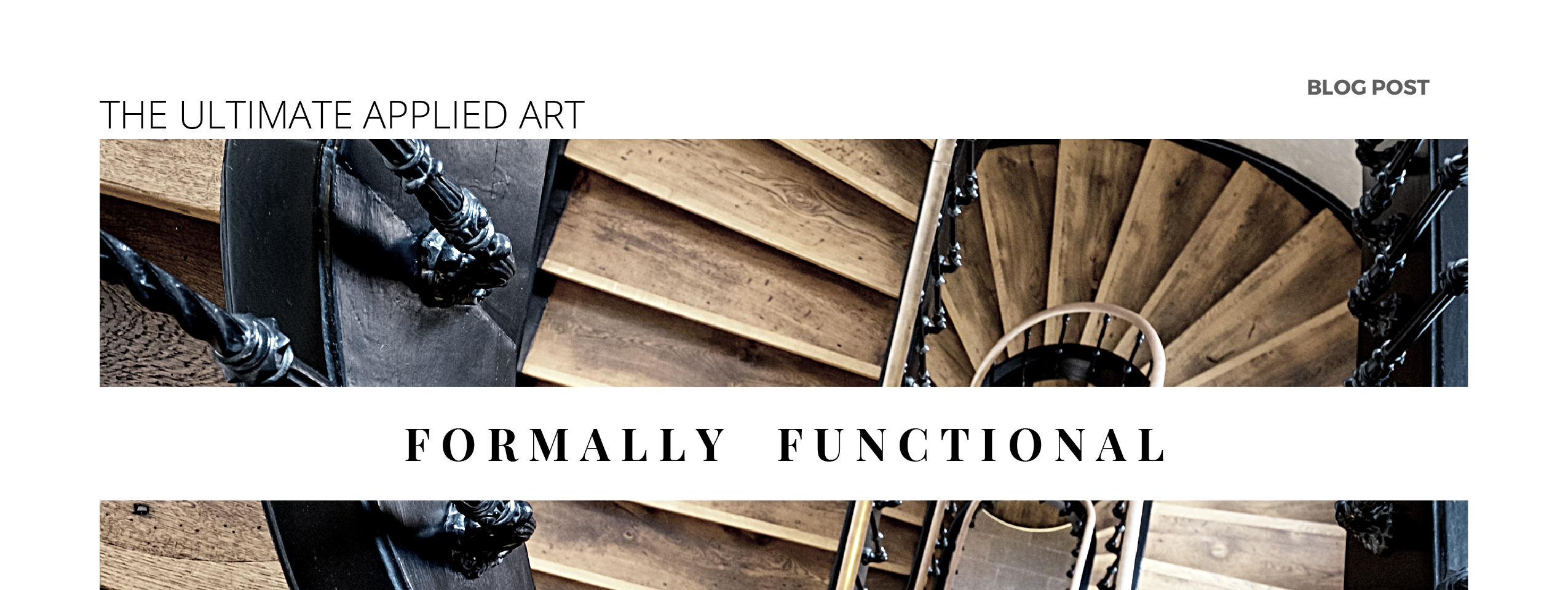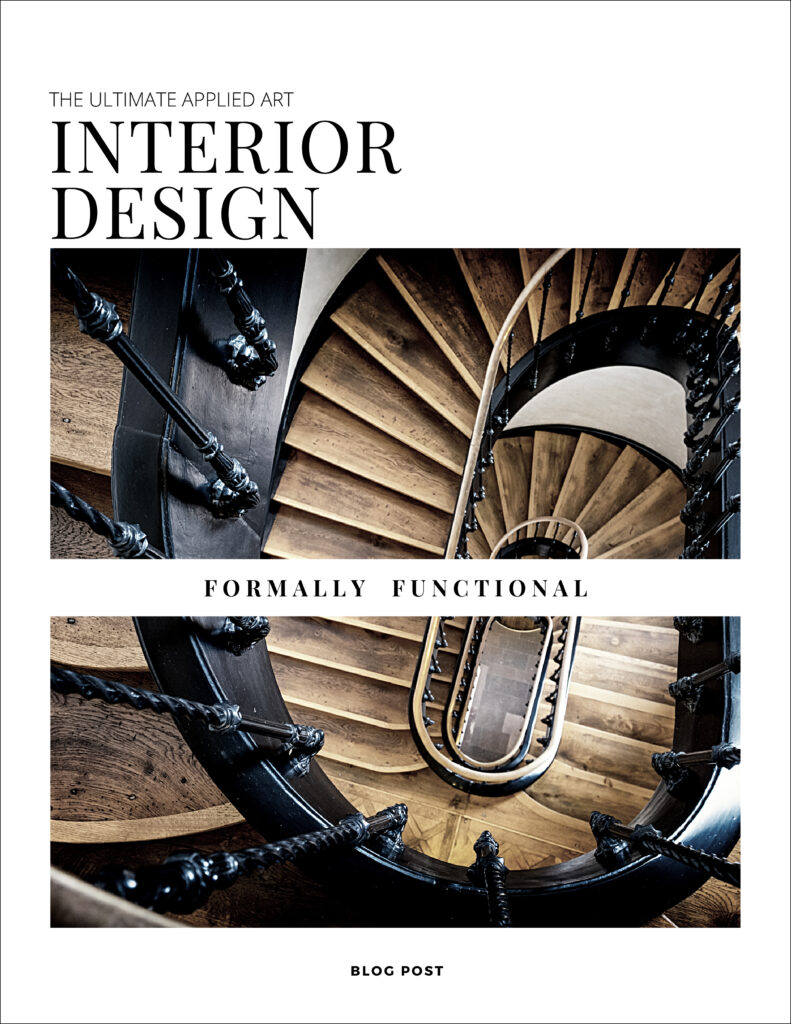Interior Design – The Ultimate Applied Art
Good design is when the form and the function are in complete balance. In fact, I would go so far as to say, that true beauty can not survive unless all the needs and functions are fully considered within the design.
They are both essential components, but the practical must come before the pretty.
When interiors consider only the end look, the result is ART. The completed room may be stunning, but if it does not provide for the everyday needs of living, the beauty will be short-lived; disrupted by the requirements of everyday life. In a sense; the “ART” will fall apart.
Conversely, when the function forgets about the aesthetic, the space lacks interest, beauty and pleasure. The room becomes under-utilised because it does not offer enjoyment.
The feelings associated within a space cannot be under-evaluated. These are essential ingredients to increase the utility of a space.
As a Designer, I aspire to understand a brief (both the functional requirements & the aesthetic desires) to determine how to make the needs fit for purpose in a stylish and considered way. This is applied. Where creative solutions are delivered with practical applications.
LIFE AS ART?
Some artists, designers and architects believe we should live life as ART.
I won’t get too deep into that philosophy, but I question the practicality?
Often when clients begin their interior design journey, functional needs are sidestepped for aesthetic utopia. I believe that’s right! There should be a moment for dreaming up the ambitions of a forever home. And, I need to understand the IDEAL, the BIG DREAM, the full ambitions, so that I can work to move as close as possible to that vision.
There are a lot of clients who begin their brief with requests for white open spaces, where their day to day objects are hidden like a streamlined paradise. I am an admirer of these clean spaces, so it’s interesting to hear their desires… even when (in most circumstances) it is completely impractical to stick to a strict minimalistic theology.
Personally, I believe minimalistic environments are more suited to large communal buildings. Brutalism, Minimalism and Ultra Modern Design are ideal in museums and office building foyers where the environment is not personalised and the requirement is not meant to be intimate. Their purpose is to deliver a sense of magnificence. The functional need is simply about providing an airy space for pedestrian traffic. The want or desire is to create an interpretation of stature, importance and progression…so that as you pass through the vast hall, you are in awe. Subconsciously you tie the grandeur to the power and stability of the businesses or artists within the building.
Now let’s tie a minimalistic style to a home. If you have ever watched Grand Designs, you know that houses that install these sculptural marvels of design are usually inhabited by an Architect or a childfree couple as a second home. My suspicion is that if were to see their day-to-day life in these houses, the look would be anything but minimalistic.
The reality is, it’s hard to get away from “the things” we all have, without negatively impacting our way of life.
We can hide integrated storage, but it won’t stop your husband from throwing his jacket on a chair, instead of hanging it up in a closet as he walks in the door.
Nor will it solve the most common request I hear:
“We don’t want our (60”) TV to be the focal point of the room, but we do want to view it from all the seated positions.”
Wow! That’s a tough one. It’s not impossible, but it’s also not aligned to the principles of a minimalistic life.
Maybe in the future, it will be possible to reduce our physical “things”?
After all,cloud-based technology is the future and televisions will be replaced by IPADS, etc, etc. It’s certainly plausible, but what I know from working with clients right now, is that we are not there yet. So, the form still follows function as the top ticket for home design.
FUNCTION BEFORE FABULOUS
Let’s remove ourselves from topics so close to home for a moment and consider another chicken or egg example of form before function or vice versa. I’m taking an educated guess that when Henry Ford made the first automotive, he wasn’t thinking
“I want to make something that looks as though it moves fast,
and once I do that, then I will figure out how to make it move.”
This would be senseless! There is no debate that making the automotive work was the primary design objective, and the look and feel of the car came some time afterwards. It’s a basic example, but let’s take it one step further and examine how this applies to the cars’ interior.
The interior design of the car must have been a priority after the cars main function of movement? This is because the interior design of any vehicle matters a lot to its utility. It needs to be fit for purpose; to reach the gas pedal, to move the clutch, to see out of the windshield, to manoeuvre the gears.
These are aspects which have a direct impact on the comfort, practicality and enjoyment of the car, as well as the function. The amount of use or longevity of a drive is to some degree, directly related to the ease and comfort the driver feels from the elements of the design.
The unsung hero of design is certainly function. The positive use of “something” is not even an afterthought when that “thing” is working well. Utility is only a priority when a design performs badly or has completely stopped working. It is then that we become aware of the importance of function.
Consider how you feel when someone has adjusted the drivers seat or the positioning of the rear-view mirror in YOUR car – It’s annoying! These design features were once ideal for you, and now they have been positioned outside of your comfort zone. Your first priority before driving isto readjusts to suit your comfort. In this moment you do not care if your car is purple with polka dots or flash red. You just care that the interior is well suited to your needs.
However, when design function is ideal, what we want next is to cater to our preferences; the things we immediately notice and respond to. It may be tinted windows or leather upholstery, or a walnut burl dashboard, these preferences are unique to each person. The principle is that we want the spaces we inhabit to be customised to us. These aesthetic elements are significant to us personally but may seem insignificant from a practical perspective. That is until we realise that they actually help us to live better.
The visual elements make us feel good. They stimulate us and impact our mood, emotions, temperature, comfort, even blood pressure. Aesthetic elements can make us happier, and they offer us personalisation which in turn helps us enjoy (use) “things” longer.
The combination of functional design and customised preferences is an example of well-executed design, with each aspect balancing the other out equally and contributing to the longevity and satisfaction of the environment.
So, as I return from my digression about function and form, I’ll take you back to one of the first moments we discussed in this article:
I am sitting in a design consultation with new clients and I am listening to their brief about their dream home. I hear them speak about open spaces, clean lines, modern aesthetic, and some preferences around minimalism etc.
I do not discount their IDEALS, but my job is also to take a pause from what they are saying and to take in the unspoken needs.
In this scenario, I am surrounded by a hallway filled with folded baby buggies, a myriad of different sized footwear, coats, hats, plastic toys, schoolbags, photo frames and car keys.
I know that their reality is one of small children who need storage. Their family will require furniture that lacks any type of sharp edge or impediment. They need hard-wearing materials that are not made of marble or glass. They will appreciate the type of furnishings where juice spills wipe up without stains and banged toys on tabletops won’t chip glass and marble surfaces. My job is to give them their ideal look without forgetting to consider the functional utility that will make their lives easier. These needs are not in their spoken brief, but it’s what the lifestyle around me is saying.
In the end, their home will not be ART, it will be APPLIED ART!
But they will never be aware of this distinction because I will propose only furnishings that function for their needs; Performance fabrics and materials which have a modern sensibility and a child-friendly shape. To them, the result will be ART, (the look they were after). As with all good design, the function and utility will labour silently in the background having been already considered in great detail before the room took form.
Now you may be thinking, I don’t have children (at home, or at all). You might debate in your mind that the outcome and requirement
for compromise would be different for your circumstances?
I would have to agree. We all have our own preferences and needs! … but let us imagine what life as ART might look like without consideration to FUNCTION.
You return home to your chic minimalist home, where the needs and functionalities are reduced from that of a young family; practicalities have taken a slight backseat to your style preferences. You enter your house and smile. The rooms look AMAZING, this is so exciting! You can’t believe YOU live HERE! Yippee. You go to put your keys and bag down, but there is no console table,… so you just drop them, that’s okay…you won’t need them until you go out tomorrow morning.
Then as you take your jacket off, you realise there is no place for your coat to hang. So…you put it on the floor too. Urgh, your coat gets dirty because there was mat to wipe your feet as you came in, and now there is a muddy puddle on the floor. This is slightly annoying, but undeterred you walk into your stunning kitchen and pour a glass of wine. Ahhh PERFECTION!
As you retire to the living room(with the intention of flopping on the sofa), you find there is no place to put your wine! You look around for a solution, but there is none! You are left holding the glass in your hand standing by the sofa. So much for a lie-down, you will need to sit up to hold your wine glass.
You decide you’ll watch a bit of telly instead, and as you recline to sit on your AMAZING low-lying curved sofa, the wine spills onto your shirt because the sofa is lower than you had imagined and lacks a supportive backrest. Frustration sets in, but it’s white wine… so no bother, it will come out.
Now that you’re down here, you take a sip of wine and look for the remote to watch the TV. There isn’t a side table for the remote to sit on, so you stuff your hands down the sides of the sofa looking for it. Success! you find the remote only to discover that the TV (which you didn’t want to have as a focal point in the room) is now impractical to turn on or even view unless you are a contortionist. You aren’t even at the right angle for the remote to connect.
The room feels a lot less beautiful now that the experience hasn’t met your basic functional expectations. This is the crux of APPLIED ART, consideration of utility is critical to the enjoyment of a designed aesthetic. All rooms need to be formally functional.



Comments are closed